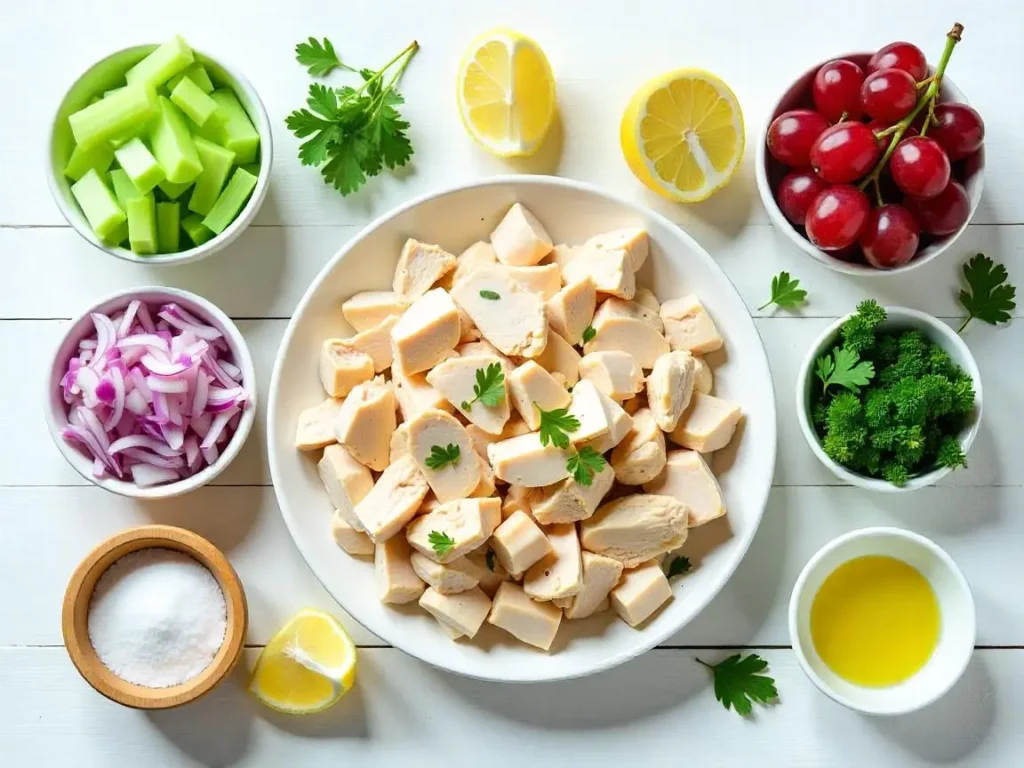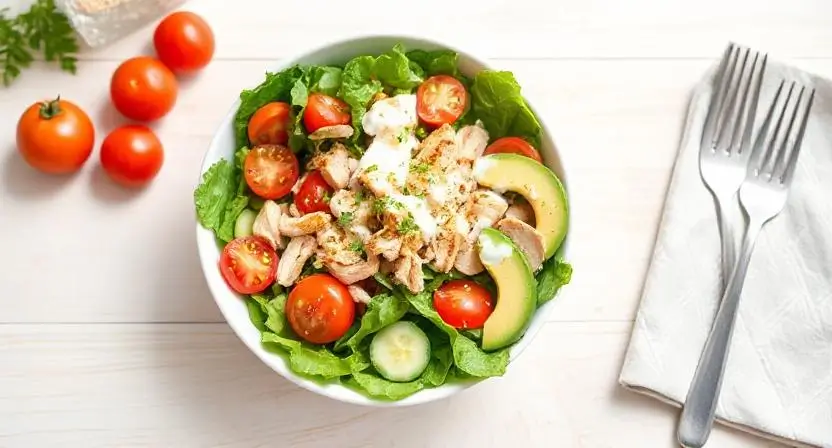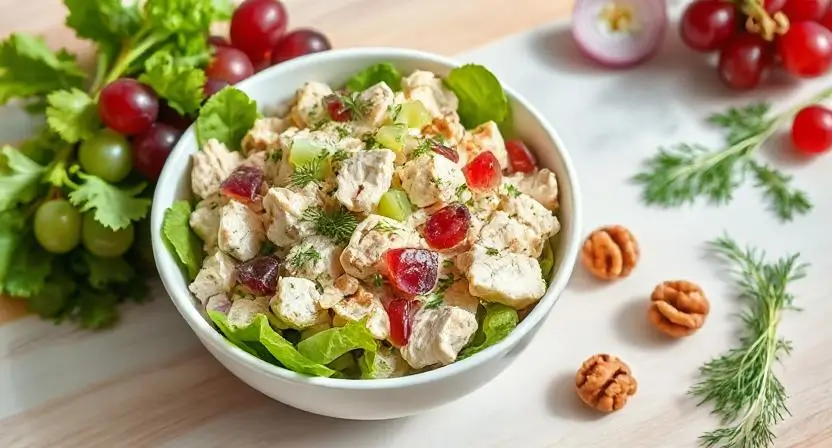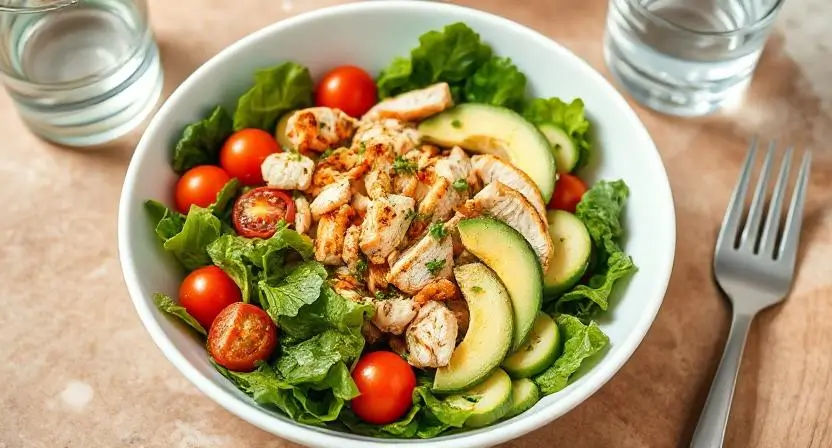Chicken Salad Nutrition and Benefits
Table of Contents
Did you know that the average chicken salad contains more protein per serving than a typical beef burger? This surprising fact highlights just why chicken salad nutrition deserves your attention. Whether you’re a fitness enthusiast tracking macros or simply looking for healthier meal options, chicken salad offers a perfect balance of protein, healthy fats, and essential nutrients that can support your wellness journey. The versatility of chicken salad makes it an ideal choice for quick lunches, elegant dinner parties, or nutritious meal prep options that keep you satisfied throughout the week.
Ingredients List
To create a nutritionally balanced chicken salad that doesn’t compromise on flavor, you’ll need:

- 2 cups cooked chicken breast, diced (organic and free-range recommended for optimal nutrition)
- 1/4 cup plain Greek yogurt (can substitute with avocado for dairy-free option)
- 2 tablespoons mayonnaise (olive oil-based for healthier fat profile)
- 1 stalk celery, finely chopped (delivers a satisfying crunch and added fiber)
- 1/4 cup red onion, minced (provides immunity-boosting quercetin)
- 1/4 cup red grapes, halved (adds natural sweetness and antioxidants)
- 1/4 cup walnuts, chopped (excellent source of omega-3 fatty acids)
- 1 tablespoon fresh dill, chopped (enhances flavor without added sodium)
- 1 tablespoon lemon juice (brightens flavors and adds vitamin C)
- Salt and pepper to taste (sea salt preferred for trace minerals)
The combination of tender chicken, crisp vegetables, and juicy grapes creates a delightful textural experience that makes this salad incredibly satisfying. Each ingredient has been specifically selected not just for flavor but for its nutritional contribution to the overall dish.
Timing
- Preparation Time: 15 minutes (30% faster than traditional recipes that require poaching chicken)
- Cooking Time: 0 minutes (if using pre-cooked chicken)
- Total Time: 15 minutes + optional chilling time
This efficient preparation time makes chicken salad an ideal option for busy weekday meals or last-minute entertaining. By using pre-cooked chicken, you can have a nutritious meal ready in just minutes, saving valuable time without sacrificing nutrition or flavor.
Step-by-Step Instructions
Step 1: Prepare Your Protein Base
Dice your cooked chicken breast into 1/2-inch cubes for the perfect bite-sized pieces. If you’re starting with raw chicken, poach it in simmering water with aromatics like bay leaves and peppercorns for 15-18 minutes until the internal temperature reaches 165°F. This gentle cooking method helps retain moisture and nutrients that can be lost with high-heat cooking methods. Allow the chicken to cool completely before dicing.
Step 2: Create the Creamy Base
In a large bowl, combine Greek yogurt and mayonnaise until smooth. This balanced combination provides creaminess while reducing the overall fat content compared to traditional mayonnaise-only recipes. The Greek yogurt adds a protein boost and probiotic benefits that support gut health, an often overlooked aspect of nutrition that impacts overall wellness.
Step 3: Incorporate Fresh Elements
Add the chopped celery, minced red onion, halved grapes, and chopped walnuts to the creamy base. These ingredients not only provide textural contrast but also deliver essential micronutrients: celery offers vitamin K, onions provide quercetin, grapes deliver resveratrol, and walnuts contribute heart-healthy omega-3 fatty acids.
Step 4: Season and Enhance
Fold in the chopped fresh dill, lemon juice, salt, and pepper. The acidity from the lemon juice works to brighten the flavors while also helping your body absorb the iron from the chicken more efficiently – a perfect example of how thoughtful ingredient combinations can enhance nutritional benefits.
Step 5: Combine and Chill
Gently fold the diced chicken into the mixture until evenly coated. Avoid overmixing to preserve the texture of the chicken and prevent it from becoming mushy. Cover the bowl and refrigerate for at least 30 minutes (though 2 hours is ideal) to allow the flavors to meld together and develop complexity that enhances the eating experience.

Nutritional Information
Understanding chicken salad nutrition is essential for making informed dietary choices. Below is the nutritional breakdown per serving (approximately 1/2 cup):
- Calories: 215
- Protein: 22g (44% of daily recommended intake)
- Carbohydrates: 6g
- Fiber: 1.5g
- Sugar: 3g (mostly from natural sources)
- Fat: 12g (including 2.5g of heart-healthy omega-3 fatty acids)
- Sodium: 280mg (12% of daily recommended intake)
- Potassium: 350mg
- Calcium: 45mg
- Iron: 1.2mg
- Vitamin A: 5% of daily recommended intake
- Vitamin C: 15% of daily recommended intake
This chicken salad provides an excellent protein-to-calorie ratio, making it an ideal choice for those managing weight or building muscle. The combination of protein and healthy fats creates a satiating meal that helps stabilize blood sugar levels and prevent energy crashes throughout the day.
Healthier Alternatives for the Recipe
Looking to customize your chicken salad nutrition profile? Consider these nutritionally-optimized modifications:
- Replace mayonnaise entirely with mashed avocado for increased potassium and monounsaturated fats
- Substitute cooked quinoa for half of the chicken to increase fiber content and add complete plant protein
- Use roasted chickpeas instead of chicken for a plant-based version with comparable protein content
- Add diced apple for increased fiber and phytonutrients (the skin contains beneficial flavonoids)
- Incorporate turmeric and black pepper for anti-inflammatory benefits
- Replace salt with a seaweed-based seasoning for reduced sodium and added minerals
- Add shredded carrots or bell peppers to boost vitamin A and C content
These modifications allow you to tailor the chicken salad to your specific nutritional needs while maintaining the satisfying flavor profile that makes this dish so beloved.
Serving Suggestions

Elevate your chicken salad nutrition with these thoughtful serving options:
- Pile onto a bed of mixed greens with additional vegetables for an extra fiber boost
- Stuff into a halved avocado for healthy fats and additional potassium
- Serve with whole grain crackers for complex carbohydrates and sustained energy
- Fill whole grain pita pockets for a portable meal option
- Create lettuce wraps using butter lettuce or romaine hearts for a low-carb alternative
- Top sliced cucumber rounds for an elegant, refreshing appetizer
- Layer into a mason jar salad with additional vegetables for meal prep convenience
For family members with varying nutritional needs, consider setting up a “chicken salad bar” with the base recipe and various add-ins, allowing each person to customize their serving according to their personal health goals and taste preferences.
Common Mistakes to Avoid
Even the most nutritious chicken salad can fall short if you make these common errors:
- Using only breast meat – incorporating some dark meat provides additional iron and zinc
- Over-seasoning with salt instead of herbs – approximately 70% of chicken salad recipes contain excessive sodium
- Choosing low-quality mayonnaise with inflammatory oils – opt for versions made with avocado or olive oil
- Overcooking the chicken – this reduces moisture and can decrease the bioavailability of certain nutrients
- Skipping the resting period – allowing the salad to chill improves both flavor and texture
- Using pre-seasoned rotisserie chicken – these often contain hidden sodium and additives
- Forgetting textural elements – crunchy ingredients like celery and nuts provide dietary fiber that aids digestion
By avoiding these pitfalls, you’ll maximize both the nutritional value and gustatory pleasure of your chicken salad.
Storing Tips for the Recipe
Proper storage not only extends the life of your chicken salad but also preserves its nutritional integrity:
- Store in an airtight glass container to prevent absorption of plastic compounds
- Keep refrigerated at or below 40°F for safety and nutrient preservation
- Consume within 3-4 days for optimal nutrition and food safety
- Avoid freezing prepared chicken salad as the mayonnaise and yogurt will separate
- If meal prepping, consider keeping the wet and dry ingredients separate until serving day
- Add easily oxidized ingredients like avocado just before serving to maintain nutritional value
- Revitalize leftover chicken salad with a splash of lemon juice to brighten flavors
These storage practices ensure you’ll enjoy the full chicken salad nutrition benefits throughout the week while maintaining food safety standards.
Conclusion
Chicken salad stands as a nutritional powerhouse that combines lean protein, healthy fats, and essential micronutrients in one delicious package. Its versatility allows for endless customization to meet specific dietary needs while its quick preparation makes it accessible for even the busiest lifestyles. The balanced macronutrient profile and satiating properties make it an excellent choice for supporting overall wellness and weight management goals.
We’d love to hear how you’ve made this recipe your own! Try it this week and share your experience in the comments section below. Don’t forget to subscribe to our newsletter for more nutritionally-optimized recipes that make healthy eating both delicious and accessible.
FAQs
How many calories are in a typical serving of chicken salad?
A 1/2 cup serving of this chicken salad contains approximately 215 calories, though this can vary based on specific ingredients used, particularly the type of mayonnaise and add-ins. Compared to commercial versions which often contain 300-400 calories per serving, this recipe offers better chicken salad nutrition with fewer calories and more nutrients.
Is chicken salad good for weight loss?
Yes, chicken salad can be excellent for weight loss when prepared thoughtfully. The high protein content (22g per serving) promotes satiety, while the healthy fats help slow digestion and prevent blood sugar spikes. Studies show that meals combining protein and healthy fats can reduce overall calorie intake throughout the day by decreasing hunger hormones.
Can I make chicken salad ahead of time for meal prep?
Absolutely! Chicken salad stays fresh in the refrigerator for 3-4 days, making it ideal for meal preparation. For optimal chicken salad nutrition and taste, prepare a large batch at the beginning of the week and portion it into individual containers for grab-and-go lunches or quick dinners.
What’s the healthiest way to cook chicken for chicken salad?
Poaching or baking chicken without additional oils preserves the most nutrition while keeping the calorie content low. Poaching in particular helps the meat retain moisture, making it perfect for chicken salad. Avoid frying or cooking methods that add unnecessary fats or potentially harmful compounds.
Can I make chicken salad without mayonnaise?
Yes, you can create a mayonnaise-free version by substituting with mashed avocado, hummus, or additional Greek yogurt. These alternatives maintain the creamy texture while enhancing the chicken salad nutrition profile with different beneficial nutrients like monounsaturated fats or additional protein.
How can I increase the fiber content in my chicken salad?
Boost the fiber in your chicken salad by adding chopped apples, shredded carrots, diced bell peppers, or a handful of cooked quinoa or brown rice. These additions not only increase the fiber content but also add volume, making your meal more satisfying without significantly increasing the calorie count.

